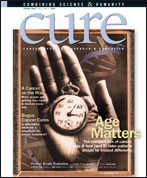Publication
Article
CURE
The Weight Gain Mystery
Author(s):
Why breast cancer patients may gain weight during treatment and how to manage it.
With chemotherapy, a breast cancer patient faces a risk responsible for not only eroding her body image but also of heightening the odds of a chronic disease: weight gain. Breast cancer treatment and weight gain, however, aren’t a pairing most people make.
Researchers first noted weight gain in breast cancer patients in 1978 and subsequent work expanded the understanding of the relationship between diet, exercise, weight gain and chemotherapy. Weight gain in breast cancer patients commonly ranges from about 5.5 pounds to about 13.5 pounds.
“Now, with us winning the war on cancer and fewer people diagnosed at later stages, people have an opportunity to have a different disease course, and being overweight is associated with a much poorer prognosis,” says Wendy Demark-Wahnefried, PhD, a registered dietitian and professor at Duke University Medical Center School of Nursing and Department of Surgery.
Research from the ongoing Women’s Healthy Eating and Living, or WHEL, study involving 3,088 breast cancer survivors linked weight gain to chemotherapy. Sixty-five percent of women receiving chemotherapy gained 5 percent or more of their pre-diagnosis weight, says Nazmus Saquib, MD, PhD, a post-doctoral fellow involved in the study at Moores UCSD Cancer Center.
Data show women treated with the hormone therapy tamoxifen showed no treatment-related weight gain, and the type of chemotherapy, either anthracycline or non-anthracycline didn’t matter, Dr. Saquib says.
Several factors may play into the added weight, but overeating isn’t considered a cause. A woman often loses lean body mass during treatment, slowing metabolism and making it harder for her body to burn calories. Also, treatment can chemically induce premature menopause, a time when women often gain weight.
And the problem isn’t always the number of pounds added. “Even if [breast cancer patients] don’t gain weight and their weight stabilizes, treatment will cause loss of muscle mass. So, they may have more fat and less muscle,” Demark-Wahnefried says. “They occupy more space and, even if they’re the same weight, they won’t fit into the same clothes.” In addition to breast cancer, studies have found a risk of weight gain during treatment for prostate and ovarian cancers.
Traditionally, exercise for cancer patients focused on the potential of aerobic exercise to reduce nausea and fatigue, but combining strength training and aerobic exercise may have more far-reaching results. Aerobic exercise and strength training, particularly a regimen emphasizing the leg region and abdomen, may prove particularly useful since research suggests the greatest loss of lean tissue occurs in these regions.
A membership to a fitness center, however, isn’t necessary, though some gyms and cancer centers offer exercise programs for cancer patients. “Resistance training is very important, as is exercise overall,” Demark-Wahnefried says. A woman can fight obesity by walking briskly for 30 minutes daily for five days a week, she says.
Diet is also important, although ongoing research still strives to determine which foods and what proportions of specific foods make the greatest difference. Most cancer centers have dietitians on staff to help patients choose the right foods.
Women who eat a low-fat, plant-heavy diet have greater odds of surviving cancer, Demark-Wahnefried says. But the research itself is inconsistent on whether eating vegetables reduces breast cancer risk, and studies on the effect of fruit continue. The Women’s Intervention Nutrition Study tested whether a low-fat diet after treatment could reduce recurrence and improve survival in localized breast cancer patients. Final results indicate a decrease in dietary fat intake may significantly reduce the risk of recurrence among postmenopausal breast cancer patients.
Final results from the WHEL study are expected in 2008, but for now, the American Cancer Society recommends an emphasis on a diet heavy in vegetables and fruits, as well as with low amounts of saturated fats and high in dietary fiber.





